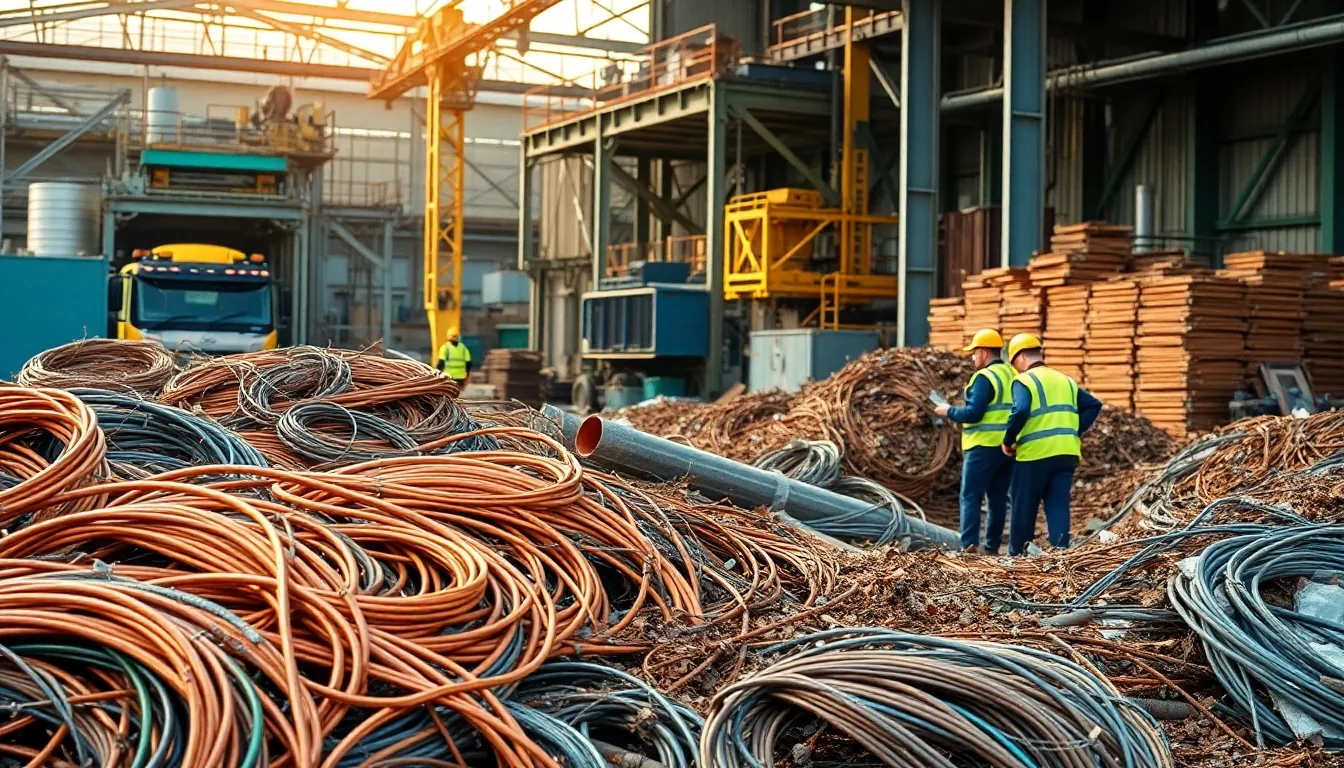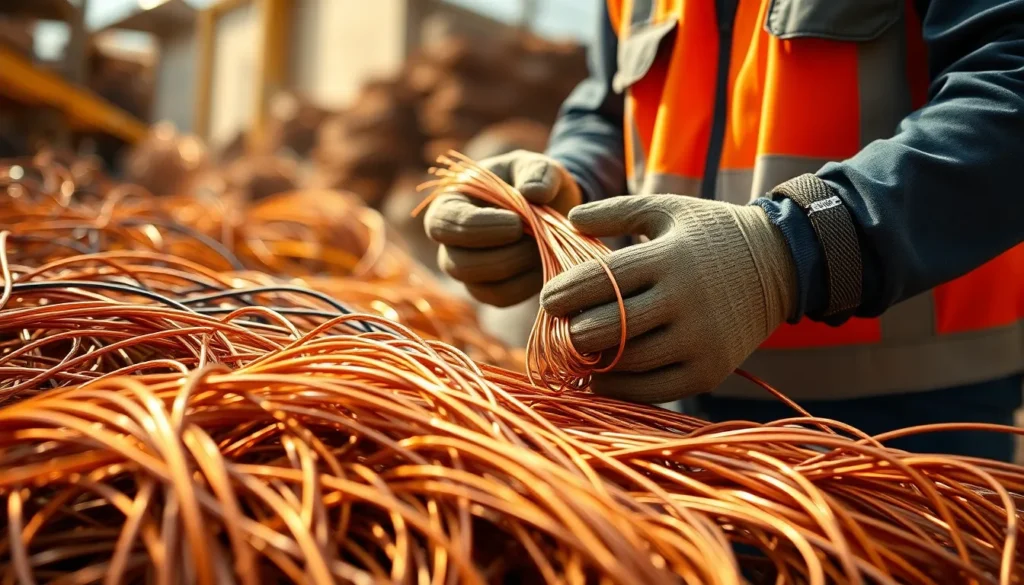Table of Contents
ToggleScrap copper prices are like a roller coaster ride: thrilling, unpredictable, and just a little bit nerve-wracking. As the world pivots towards renewable energy and electric vehicles, copper’s role in the economy is becoming more vital than ever. Investors and recyclers alike are on the edge of their seats, eager to know whether they should hold onto that scrap pile or cash in before the market takes a nosedive.
Future Scrap Copper Price Predictions
Market analysts project fluctuations in scrap copper prices due to global demand, economic changes, and geopolitical factors. Increased investments in renewable energy and electric vehicle production enhance copper’s value, driving price growth. Supply chain disruptions, often triggered by natural disasters or trade tensions, may contribute to unexpected price surges.
Current trends suggest that if infrastructure spending escalates, particularly in the U.S., copper demand could rise sharply. According to Trading Economics, experts anticipate prices averaging around $4.50 per pound over the next five years, contingent upon sustained industrial activity.
Growing recycling efforts also impact future prices. As firms focus on sustainability, demand for scrap copper remains strong. Recyclers navigating the market may benefit from higher prices as supply tightens and longer-term trends evolve.
Investors often evaluate copper’s role as a hedge against inflation. Historical data indicates that during times of economic uncertainty, copper retains its value better than many commodities. Financial analysts point out that as nations increase investments in green technologies, copper’s importance solidifies.
While market predictions remain uncertain, strong demand and ongoing reforms in energy sectors imply that scrap copper prices are likely to experience upward trends. Stakeholders must stay alert and adapt quickly to these market dynamics.
Factors Influencing Scrap Copper Prices

Numerous elements impact scrap copper prices, encompassing both market dynamics and broader economic conditions.
Supply and Demand Dynamics
Demand for copper rises with increased manufacturing and construction activity. Manufacturers require copper for electrical components, making it essential for various industries. A decline in copper supply can result from restrictions on mining or increased recycling initiatives. Economies transitioning to renewable energy and electric vehicles heighten the need for copper, causing prices to fluctuate. The balance between supply and demand dictates price trends, as seen with recent spikes during periods of high industrial activity.
Global Economic Trends
Global economic conditions significantly alter scrap copper prices. Economic growth in countries like China and India drives robust demand for copper, impacting international trade. Inflationary pressures can reduce purchasing power but often lead to increased investment in commodities like copper. Trade policies and geopolitical tensions create uncertainties that influence market stability. Analysts note that infrastructure spending, especially within the U.S., may further strengthen this trend, driving up prices over the coming years.
Historical Price Trends of Scrap Copper
Scrap copper prices have exhibited significant volatility over the years, impacting recycling and investment decisions. This volatility stems from various market influences, including economic factors and global demand for copper.
Significant Price Fluctuations
Price fluctuations in scrap copper have been substantial over the last two decades. Prices ranged from around $0.80 per pound in the early 2000s to highs of nearly $4.00 per pound in 2021. Such fluctuations reflect changing industrial demands and global economic conditions. Sudden price changes often occur due to supply chain disruptions, trade policies, and shifts in the oil market, which directly affect copper extraction and transportation costs. Seasonal trends also contribute, with prices rising during peak construction seasons. Understanding these fluctuations aids recyclers and investors in navigating future market challenges effectively.
Long-Term Trends
Long-term trends indicate that scrap copper prices generally rise in line with increased industrial production. Historical data suggests consistent upward trends after economic downturns, driven mainly by a surge in infrastructure spending and renewable energy initiatives. During the last decade, the average price has increased, aligning with heightened demand from electric vehicle manufacturing and energy sectors. Analysts envision stability in pricing, particularly as countries intensify their focus on sustainability and recycling efforts. Continuous investment in infrastructure projects across major economies can also reinforce this demand, further impacting prices in the years ahead.
Expert Insights and Market Analysis
Market analysts anticipate continued fluctuations in scrap copper prices influenced by evolving economic factors. Analysts predict average prices reaching approximately $4.50 per pound over the next five years. Increased demand from the renewable energy sector and electric vehicle production drives this optimism. Specifically, the U.S. infrastructure plans may further escalate the need for copper, bolstering market stability. Additionally, ongoing recycling initiatives contribute positively, maintaining a robust demand for scrap copper.
Predictions from Industry Analysts
Analysts emphasize the importance of supply and demand dynamics in determining future prices. Significant growth in manufacturing and construction sectors contributes to increasing copper demand. Mining restrictions may constrain supply, further enhancing price stability. Economists also note the role of global growth, particularly in major markets like China and India, which substantially influences copper demand. Analysts highlight that inflationary pressures often redirect investments towards commodities, including copper. Adapting to these market trends remains crucial for stakeholders in the copper industry.
Impact of Environmental Regulations
Environmental regulations are shaping the future of scrap copper pricing. Stricter regulations on mining practices can limit supply, prompting a surge in recycled copper demand. Enhanced recycling efforts align with global sustainability goals, fostering a healthier market environment. Policies aimed at reducing carbon footprints also encourage investments in electric and renewable energy industries, increasing copper usage. Compliance with these regulations drives companies to innovate in recycling technologies, boosting overall market confidence. As the focus on sustainability grows, demand for scrap copper will likely remain strong, influencing its price trajectory.
The future of scrap copper prices appears promising yet fraught with uncertainty. As the demand for copper continues to rise due to renewable energy initiatives and electric vehicle production, stakeholders must remain vigilant. The interplay of supply chain dynamics and economic factors will undoubtedly shape the market landscape.
Investors and recyclers are encouraged to adapt to these changes and consider the potential for price fluctuations. With projections suggesting an average price of around $4.50 per pound over the next five years, the emphasis on sustainability and recycling will likely play a crucial role in determining future trends. Staying informed will be key to navigating this evolving market.







